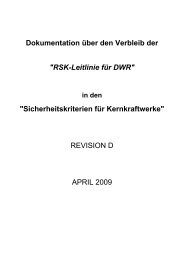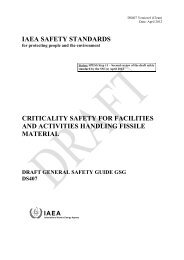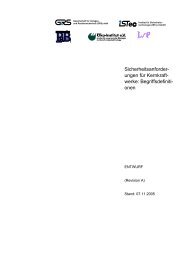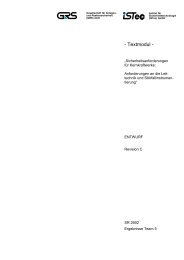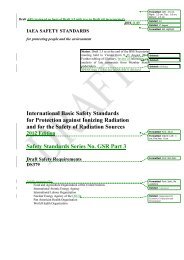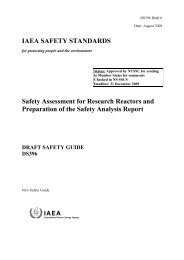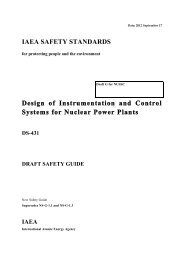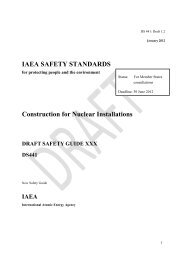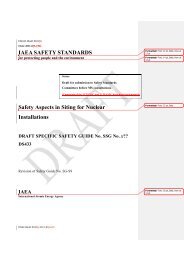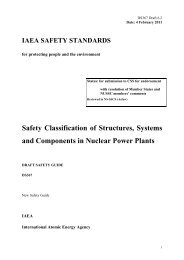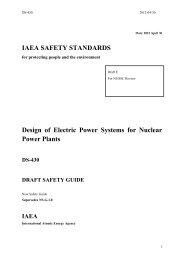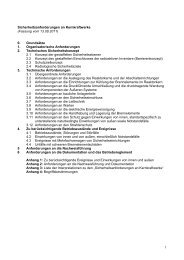DS397 Saf Use Mod RRs with NUSSC comments 18-06-2010
DS397 Saf Use Mod RRs with NUSSC comments 18-06-2010
DS397 Saf Use Mod RRs with NUSSC comments 18-06-2010
Create successful ePaper yourself
Turn your PDF publications into a flip-book with our unique Google optimized e-Paper software.
1. INTRODUCTIONBACKGROUND1.1. This <strong>Saf</strong>ety Guide was developed under the IAEA programme for safety standards forresearch reactors, which covers all the important areas of research reactor safety. TheFundamental <strong>Saf</strong>ety Principles publication [1] establishes principles for ensuring theprotection of workers, the public and the environment. This <strong>Saf</strong>ety Guide directly addressesfour of these principles, i.e.: responsibility for safety, optimization of protection, limitation ofradiation risks to individuals and prevention of accidents 1 . Also, the present <strong>Saf</strong>ety Guideprovides guidance on implementing the requirements established in the IAEA <strong>Saf</strong>etyRequirements on the <strong>Saf</strong>ety of Research Reactors, NS-R-4 [2], for ensuring adequate safety atall stages of the lifetime of a research reactor. In particular, guidance is given on whichanalyses, verifications and evaluations should be performed to fulfil the safety objectives ofthe requirements for the operating organization that are established in paras 2.15; 2.17–2.20;3.6–3.12 and 4.14 of Ref. [2].1.2. The present publication supersedes IAEA <strong>Saf</strong>ety Series No. 35-G2 2 ; it is harmonized<strong>with</strong> the body of IAEA <strong>Saf</strong>ety Standards and <strong>with</strong> the publications being developed <strong>with</strong>in theframework of the IAEA programme on research reactor safety.1.3. Owing to the particular characteristics of research reactors, the safety aspects relatedto design and operation have been given special emphasis and have been incorporated in Ref.[2]. These characteristics include the large variety of designs, the wide range of powers, thedifferent modes of operation and purposes of utilization, the particularities of siting, and themajor differences among the types of research reactor owners and operating organizations.These characteristics require a graded approach 3 in the application of the requirements (Ref.[2], paras 1.11.–1.14), i.e. flexibility in the implementation of objectives and the fulfilment of1 These are Principles 1, 5, 6 and 8 (see Ref. [1]):− Principle 1: “Responsibility for safety: The prime responsibility for safety must rest <strong>with</strong> the person ororganization responsible for facilities and activities that give rise to radiation risks.”− Principle 5: “Optimization of protection: Protection must be optimized to provide the highest level ofsafety that can reasonably be achieved.”− Principle 6: “Limitation of risks to individuals: Measures for controlling radiation risks must ensure thatno individual bears an unacceptable risk of harm.”− Principle 8: “Prevention of accidents: All practical efforts must be made to prevent and mitigate nuclearor radiation accidents.”2 INTERNATIONAL ATOMIC ENERGY AGENCY, <strong>Saf</strong>ety in the Utilization and <strong>Mod</strong>ification of ResearchReactors, <strong>Saf</strong>ety Series No. 35-G2, IAEA, Vienna (1994).3 Further guidance on graded approach is provided in Ref. [3].1




